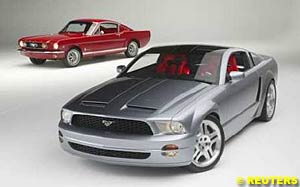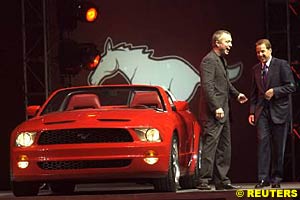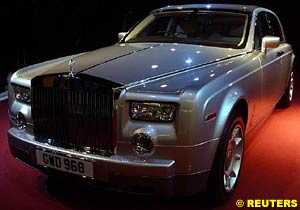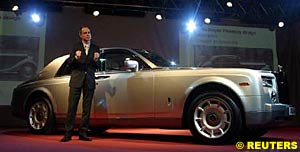

Automotive News and Reviews for the Petrolhead
Reuters Motoring Commentator
In this week's issue:
- The Rebirth of the Mustang Legend
- BMW Presents the New Rolls Royce
- David Lynch Invents 'Micra Speak'
Next year marks the 40th anniversary of one of America's legendary muscle cars, the Ford Mustang.
In 1964 a willing generation of baby-boomers were just coming of (car-buying) age and the Mustang was the sensational answer to their automotive prayers.
On its first day of sale, April 17th 1964, some 22,000 Mustangs were delivered and by 1966 over 1,000,000 had been sold. The new car's popularity led to one Chicago restaurateur advertising his hotcakes as "selling faster than Mustangs".
In the action thriller Bullitt, McQueen exploited his own passion for speed behind the wheel of that year's GT390 Mustang, insisting on performing his own stunts during one of the most celebrated movie car chases ever shot.
Bullitt was not the Mustang's only cinematic outing by any means. This car's film credits rival those of Christopher Lee and include three Bonds (Diamonds Are Forever, Thunderball and Goldfinger) as well as both the original and the remake of Gone in 60 Seconds.
Although the longevity of the Mustang story is founded on its heritage as a classic American muscle car, it was also the first of what were known as the 'Pony cars'.
In essence, these were less fearsome versions of muscle cars; powerful-looking sports-orientated coupes that hid more economical six-cylinder and smaller capacity V8 engines. They weren't so fast but they were more economical. Everything is relative of course.
An 'Economical' V8
This was 1960's America. Even today, the idea of an 'economical V8' has an oxymoronic ring to it and US motorists of 40 years ago were driving cars the size of bungalows and prospecting for oil at the weekends to ease the burden of filling them up.
By 1971, even the Mustang had put on weight and two years later the longest and widest version yet proved to be something of a swansong for the purity of the original concept. Just as the Mustang was about to celebrate a decade as the nation's favourite, a calamitous case of poor timing saw the launch of this most corpulent version coincide with the beginning of the US fuel crisis.
After all, if America can buy American, America will. This blind loyalty continued throughout the remainder of the Seventies but as the Eighties dawned, the Mustang seemed to wilt under the strain of it all. This decade marked the 'third generation' body style although it was anything but easy on the eye.
Feeble Performance
Worse still, this once-revered 'muscle car' reached a new low in terms of performance with a 1980 model that developed a feeble 119 BHP from its V8 block. And this was the top-of-the-range model. Driving it must have been the motoring equivalent of watching a Monsters of Rock concert whilst listening to it through a pair of Walkman headphones.
Worse was to come in the early Nineties as public interest in the car began to seriously wane and flagging sales demanded urgent action from Ford. In 1994 the fourth major re-design was introduced although just how far the Mustang had fallen was more than apparent. The design team appeared most excited by the re-introduction (after 16 years!) of the galloping horse badge on the radiator grill.
Advertising for a special-edition Cobra version boasted that the latest Mustang "is what it was", surely the most public acknowledgement possible of how underwhelming the previous 20 years' cars had become. But eight million customers cannot be wrong.
The Mustang is the second longest model line in Ford's 100 year history and as the accompanying pictures show, the latest design concept for next year's all-new 40th anniversary version demonstrate that Ford's designers favour a voguish retro look that owes much to the vision for the original car.
Sleeping Giant Wakes Again
Mays himself unveiled the Mustang Concept, a very good showcase for next year's all-new car, at January's North American International Auto Show. Mays was keenly aware of his responsibility for the rebirth an American motoring icon.
"When you're designing a new Mustang, you're the steward of 40 years of automotive history. If you don't get it right, you've got eight million Mustang fans to answer to. I think we got it right."
A remarkable new chapter in the history of one of the most famous names in motoring began this month, when the first BMW-built Rolls-Royce was presented to the world.
BMW acquired the automotive rights to Rolls-Royce in 1998 and immediately had to find a new home for the historic company. A carefully landscaped 65 million pound state-of-the-art complex has been established on the edge of Lord March's Goodwood estate, in West Sussex, and this is now the global headquarters for Rolls-Royce Motor Cars Ltd, the official title of the new company. Four years is not a long time to build such a facility from scratch, nor is it long to create such an important vehicle from the ground up, but this is what BMW has achieved.
Designing the new car began in secret in London, in early 1999 from offices close to the heart of Mayfair and Belgravia. Rolls-Royce Chairman and Chief Executive Tony Gott felt this was where the designers would "see the Spirit of Ecstasy in one of its natural habitats". This attention to detail has long been associated with the marque.
Before launch, Tony Gott explained, "When people buy a new Rolls-Royce they are buying a product which is like no other motor car, from basic concept right through to design. This will be obvious to people as soon as they see the new car." Clearly the reality fulfils the vision. The car looks every inch a Rolls-Royce, revisiting the poise and grace of the quintessential Rolls-Royces of the Thirties, Forties and Fifties, but with an undeniable modernity, perhaps even quirkiness, to its lines (particularly from the front).
The difficult balance between traditional and contemporary has been struck, perfectly demonstrated by a revolving section of the new Phantom's dashboard. Facing forward, this veneered panel houses a traditional analogue clock. Once rotated through 180 degrees, it reveals the monitor for all vehicle settings, satellite navigation, on-board television and telephone system.
Technically, the car has pushed the envelope of modern motor manufacturing. The Phantom has a hand-built aluminium space-frame chassis and a 6.75 litre V12 engine developing 453bhp that is good for 149mph. But a Rolls-Royce has always been about 'waftability', the seemingly effortless smooth power delivery of the engine, and BMW has carefully engineered the new motor to these ends. In technical terms, this is all about torque and 75% of the Phantom's total power is available from just 1,000rpm; in layman's terms, this means the car will pull away rapidly, smoothly and in complete comfort for its passengers, at any speed.
Passenger comfort has always been of paramount importance to Rolls-Royce owners and once again, the devil is in the detail. The rear 'coach doors' of the Phantom are hinged at the back, not the front as on conventional cars. The passenger compartment has a virtually flat floor, without intrusion from a transmission tunnel, and the roofline is at its highest point over the rear doors.
Consequently, passengers are able to enter and exit the Phantom more gracefully. Once inside, having settled back into a deep lounge seat trimmed in the softest leather available, the door can be closed at the touch of a button. Should it be raining upon arrival at the chosen destination, passengers simply remove one of the umbrellas stored in each of the rear doors.
Perhaps this is only to be expected for a car that will cost upwards of £100,000. It is certainly consistent with the image of Rolls-Royce that was first established by Charles Rolls and Henry Royce.
For some traditionalists, however, it is not enough and the issue is one of nationalism and ownership. "The car is a German-designed car with a German engine and it is made in Germany," says Michael Shrimpton, non-executive Chairman of Crewe Motors Ltd, a bidding vehicle established to compete head-on with BMW in 1998.
"It is only painted and finished at Goodwood. The soul of Rolls-Royce is British. It is, and always has been, a symbol of our freedom. The name will always be symbolic with the Spitfire plane, our victory over the Luftwaffe in 1940 and our survival as a nation."
Bellicose jingoistic hysteria or a brand of stirring patriotism that is all too lacking in Britain today? It doesn't really matter, because BMW acquired the rights to Rolls-Royce in 1998 and four years later has produced an all-new car that would appear to be more than worthy of the name. And they didn't do too bad a job of re-inventing that other British motoring icon, the Mini, did they?
If you're one of those people who consider television advertisements to be more interesting than actual programmes these days, look out for the new Nissan Micra commercials.
Nissan considers its new small car is so distinctive, it should have its own language and has employed acclaimed film director David Lynch to be our teacher.
You couldn't make it up, could you? It seems possible that the creative directors at TBWA/G1, Nissan's advertising agency, might have been up late watching A Clockwork Orange, perhaps?
The agency was briefed to develop a campaign to reflect the new car's unique mix of values and persuaded Lynch, the innovative director of such film and TV classics as Blue Velvet, Eraserhead and Twin Peaks, to interpret this vision for the commercial. "I like the Micra, particularly the headlamps. They are like jewels. And I like the concept of 'Do you speak Micra?'. I like modern and retro put together to make modtro - that's a very good concept." Well, he would say that, wouldn't he?
During the shoot, Lynch and accomplished French Director of Photography, Jean-Yves Escoffier, adopted an experimental approach and filmed the car with 'mystery, sensuality and with a sense of the bizarre'. Highlights include the liberal use of pyrotechnics, surreal blue lips in 3D to mouth the language of Micra and lighting effects that could only be achieved with the help of a helicopter and a parachute.
No doubt Nissan needs to sell a considerable number of new Micras to help show a return on the budget required for such a commercial and media campaign. Fortunately, its predecessor was a phenomenal success and critical reaction to the new car has already been very positive. The ad campaign airs across Europe since January 2003 and the car itself went on sale from January 15th. In the language of Micra, guck (good + luck) everybody.
More Micra-speak you might enjoy:
![]() The Rebirth of the Mustang Legend
The Rebirth of the Mustang Legend
 This was to become the classic era for the car as each year saw newer, more powerful models introduced, and in 1968 the Mustang's immortality was secured at the hands of another American legend, actor Steve McQueen.
This was to become the classic era for the car as each year saw newer, more powerful models introduced, and in 1968 the Mustang's immortality was secured at the hands of another American legend, actor Steve McQueen.
 1974's Mustang II was a pale shadow of its former self in all but name. The spirit, looks and performance were gone. There was even an asthmatic 88 BHP four-cylinder version but still the car sold well. It was Ford's response to market forces, providing customers with a more economical version of a much-loved car whilst fending off increased competition from Japanese and European manufacturers.
1974's Mustang II was a pale shadow of its former self in all but name. The spirit, looks and performance were gone. There was even an asthmatic 88 BHP four-cylinder version but still the car sold well. It was Ford's response to market forces, providing customers with a more economical version of a much-loved car whilst fending off increased competition from Japanese and European manufacturers.
 Under the bonnet, the indications are that this sleeping giant is about to be re-awoken: 400 BHP from a supercharged 4.6 litre V8 engine bodes well! This design study is the joint effort of Ford's Living Legends studio in Michigan and its Southern California Design Centre. The entire team is headed-up by Ford Motor Company's Vice President for Design, J Mays.
Under the bonnet, the indications are that this sleeping giant is about to be re-awoken: 400 BHP from a supercharged 4.6 litre V8 engine bodes well! This design study is the joint effort of Ford's Living Legends studio in Michigan and its Southern California Design Centre. The entire team is headed-up by Ford Motor Company's Vice President for Design, J Mays.
![]() BMW Presents the New Rolls Royce
BMW Presents the New Rolls Royce
 The Spirit of Ecstasy is, of course, the ornamental statuette that sits atop the radiator grille of a Rolls-Royce. It is an historic symbol of the marque and the new car's designers have been careful to acknowledge this heritage every step of the way. Nowhere is this more immediately apparent than in the new car's name - Phantom - the moniker for one of Rolls-Royce's landmark vehicles of the 1930s.
The Spirit of Ecstasy is, of course, the ornamental statuette that sits atop the radiator grille of a Rolls-Royce. It is an historic symbol of the marque and the new car's designers have been careful to acknowledge this heritage every step of the way. Nowhere is this more immediately apparent than in the new car's name - Phantom - the moniker for one of Rolls-Royce's landmark vehicles of the 1930s.
 At times, this attention to detail is quite breathtaking. The centre-caps of all four wheels have been perfectly synchronised to ensure that the interlinked Rolls-Royce emblem is always in an upright position, just as you'd find on a motor show display vehicle.
At times, this attention to detail is quite breathtaking. The centre-caps of all four wheels have been perfectly synchronised to ensure that the interlinked Rolls-Royce emblem is always in an upright position, just as you'd find on a motor show display vehicle.
![]() David Lynch Invents 'Micra Speak'
David Lynch Invents 'Micra Speak'
 The concept is based around the fusion of key descriptive words about new Micra, which forms a unique lexicon of terminology for the car. For starters, the car is considered to be modtro (modern + retro), offering compacious (compact + spacious) yet luxurable (luxurious + affordable) accommodation with aggrendly (aggressive + friendly) styling.
The concept is based around the fusion of key descriptive words about new Micra, which forms a unique lexicon of terminology for the car. For starters, the car is considered to be modtro (modern + retro), offering compacious (compact + spacious) yet luxurable (luxurious + affordable) accommodation with aggrendly (aggressive + friendly) styling.
© 2007 autosport.com . This service is provided under the Atlas F1 terms and conditions.
|
Volume 9, Issue 6
Articles
The Cult of a Personality
A Driver's Dream
Back to the Future: The FIASCO War
Missing Senna
Columns
Bookworm Critique
On The Road
Elsewhere in Racing
The Weekly Grapevine
> Homepage |